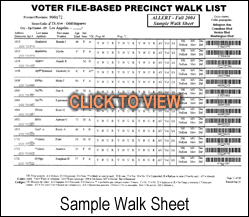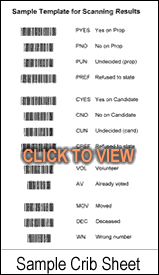 |
 |
Once the field campaign gets started, you’ll be falling into a routine of list production, door knocking and/or phone calling and, finally, data entry. Then the process begins again for further canvassing and data collection. In this section, we'll cover the beginning and end of the cycle.
 Your walk lists should be organized so that the walkers can orient themselves quickly to their area of work. They should also be very easy to use to record the results of the inquiry.
Your walk lists should be organized so that the walkers can orient themselves quickly to their area of work. They should also be very easy to use to record the results of the inquiry. A call sheet is basically the same as a walk sheet with phone numbers and without the need to sort by location as the sequence in which people are called is usually unimportant. In fact, if phone number is added to a walk sheet, it can be used for both walking and calling.
Even if you have PDAs available for your canvass work, the basic data to be downloaded is essentially the same as for a walk sheet. You do have the option for additional information that you can’t fit on a sheet of paper, but you want to keep in mind that too much information can be difficult to manage and takes up a great deal of canvassers’ time.
Once a day’s canvass is completed, the next challenge is getting the results into the computer system for analysis and campaign management. When working with PDAs the task is simple – connect the PDA to the computer and upload the data. But the vast majority of grassroots campaigns don’t have the capital to support PDAs however, so most likely the information is coming back on paper.

This is when the well-planned campaign scans in the responses with a barcode reader. The scanner reads its own special font that looks like the UPC code on virtually every product. It is a device that fools the computer into thinking that what was scanned was keyed on the keyboard.
Using a data entry program that retrieves the voter’s information by a unique code, the data entry volunteer first scans the barcoded voter ID off the walk sheet. This brings up the individual’s record. Then a form is displayed with the address, phone number and places to enter responses to the survey questions. Since the survey questions have predetermined answers, and the canvasser circled them on the paper, it’s a simple and fast task for the data entry person to scan the correct answer from a crib sheet with the possible answers (such as yes, no, etc.) encoded in the special barcode friendly font. You can watch as Risa Brown, ALLERT’s Information Technology Associate, scans in responses to a survey conducted by canvassers.
Addresses, name and telephone number corrections have to be entered by hand, however. Paper/scanner systems don’t have a way to recognize an individual canvasser’s handwriting. In this situation, a canvassing system with PDA’s would save time on data entry, if the canvasser took the extra time to enter the address changes on the PDA.